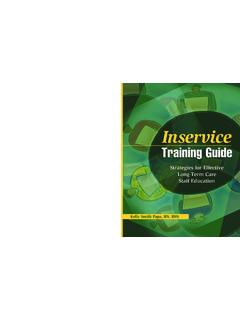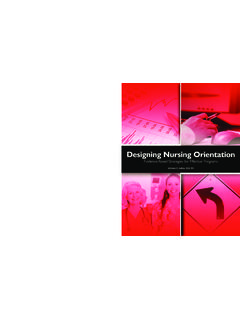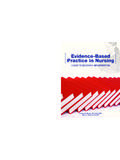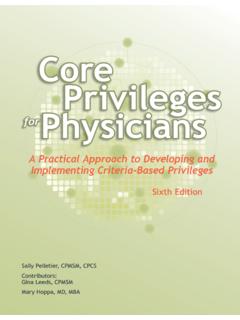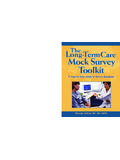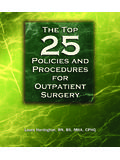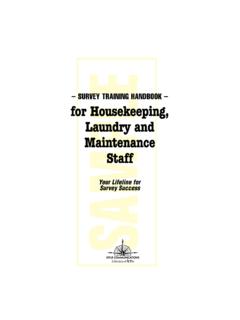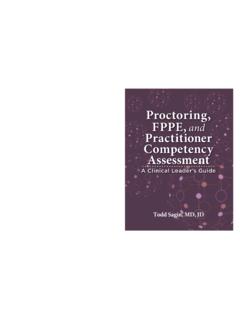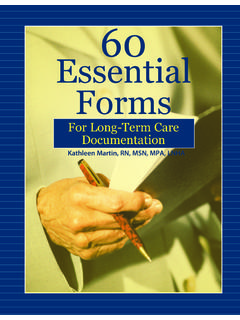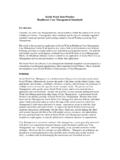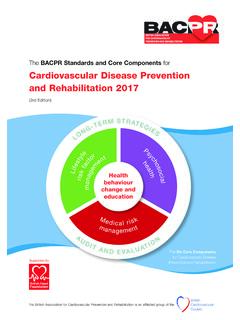Transcription of 50 Essential In-Services for Home Health
1 50 EssentialIn-Services for home Health :Lesson Plans and Self-Study Guides for Aides and by Diane Link, RN, MHA and Faith Williams, BS, RN38693 DHHH50EI Book Cover 19/20/17 12:40 PM50 Essential In-Services for home HealthLesson Plans and Self-Study Guides for Aides and NursesReviewed by Diane Link, RN, MHA and Faith Williams, BS, RN50 Essential In-Services for home Health is published by , a division of Simplify Compliance LLC. Copyright 2017 rights reserved. Printed in the United States of America. 5 4 3 2 1 Download the additional materials of this book at : 978-1-68308-603-1No part of this publication may be reproduced, in any form or by any means, without prior written consent of HCPro or the Copyright Clearance Center (978-750-8400). Please notify us immediately if you have received an unauthorized provides information resources for the healthcare industry. HCPro is not affiliated in any way with The Joint Commission, which owns the JCAHO and Joint Commission Link, RN, MHA, Reviewer Faith Williams, BS, RN, Reviewer Tami Swartz, Editor Maria Tsigas, Product Manager Erin Callahan, Vice President, Product Development and Content Strategy Elizabeth Petersen, President, Matt Sharpe, Senior Production Manager Vincent Skyers, Design Services Director Sherry Newcomb, Layout/Graphic Design Zak Whittington, Cover Designer Advice given is general.
2 Readers should consult professional counsel for specific legal, ethical, or clinical questions. Arrangements can be made for quantity discounts. For more information, contact:HCPro 35 Village Road, Suite 200 Middleton, MA 01949 Telephone: 800-650-6787 or 781-639-1872 Fax: 800-639-8511 E-mail: HCPro online at: and 2017 , a division of Simplify Compliance, LLC 50 Essential In-Services for home Health iiiTable of Contents1. Alzheimer s Disease ..12. Amputation: Understanding Barriers and Strategies for Recovery ..133. Arthritis ..254. Assistive Devices ..375. Behavior Management ..476. Behavioral Health ..557. Bloodborne Pathogens ..658. Chronic Conditions ..77 9. Communication ..97 10. Cultural Diversity ..10711. Dementia Care ..11712. Depression and Anxiety ..12513. Diabetes ..13514. Dysphagia ..14715. Elder Abuse and Neglect: Prevent, Recognize, and Report ..15916. End-of-Life Care.. 16917. E t h i c s ..17918. Hand Hygiene ..191 19. Heart Health and Disease ..20520.
3 HIPA A ..215 21. home Health Care CAHPS ..227 22. Incontinence and Constipation ..24123. Infection Control: Guidelines for Standard and Additional Precautions ..255iv 50 Essential In-Services for home Health 2017 , a division of Simplify Compliance, LLCCONTENTS24. Kidney Disease ..26525. LGBT Patients ..279 26. Lifting and Transferring Patients ..29527. Malnutrition and Dehydration ..30728. Multiple Sclerosis ..31729. Nutrition: Guidelines for Balanced Meals and Special Diets ..33130. OASIS-C2 ..34131. Obesity ..35532. Oxygen Therapy ..37133. Pain Management ..37934. Parkinson s Disease ..38735. Patient Education ..39736. Personal Care ..40737. Plan of Care ..419 38. Professionalism and Accountability ..42739. Psychosocial Care ..44140. Range of Motion and Positioning ..45141. Readmissions: Preventing a Trip Back to the Hospital ..46342. Respiratory Disorders ..47743. Seizures and Strokes ..49144. Skin Care: Guidelines for Ensuring Skin Integrity ..503 45. Social Media Safe Practices.
4 515 46. Traumatic Brain Injury ..529 47. Tube Feeding and Oral Care.. 54348. Urinary Catheter Care ..55549. Vital Signs ..56950. Zika ..581 2017 , a division of Simplify Compliance, LLC 50 Essential In-Services for home Health 11 Alzheimer s DiseaseTEACHING PLANTo use this lesson for self-study, the learner should read the material, do the activity, and take the test. For group study, the leader may give each learner a copy of the learning guide and follow this teaching plan to conduct the lesson. Certificates may be copied for everyone who completes the OBJECTIVESP articipants will be able to: Recognize signs of Alzheimer s disease Apply suggestions that may make caring for patients with Alzheimer s disease easier Use techniques for handling difficult behaviors in a compassionate wayLESSON ACTIVITIES1. Ask participants to remember a time when they faced an unfamiliar situation. The first day of a new job, for example, usually requires talking to strangers, figuring out unfamiliar routines and tasks, and getting around in a strange building.
5 Encourage the learners to tell you how they feel in such situations. Some natural feelings include confusion, puzzlement, nervousness, insecurity, or even fear. Explain to partici-pants that people with Alzheimer s disease feel this way all the time. The world is more puzzling to them every day. Everyone seems to be a stranger, nothing seems familiar, and abilities they used to have are gone. When we try to see situations from the point of view of people with Alzheimer s, it is easy to under-stand why they are sometimes anxious, irritable, or Distribute index cards or paper. Ask each learner to write down a problem or question about caring for people with Alzheimer s disease. Have the learners fold the papers or cards and place them in a box or basket you provide. Hand out copies of the learning guide. Have each learner draw a card from the basket. Instruct the learners to read the learning guide and try to find an answer to the question or prob-lem. Allow enough time for everyone to find their answer, and then ask learners to read their question or problem aloud to the group and explain the answer they found.
6 If there is no answer for the problem in the learning guide, have learners discuss possible solutions based on the principles in the 50 Essential In-Services for home Health 2017 , a division of Simplify Compliance, LLCALZHEIMER S DISEASETHE LESSONR eview the material in the lesson with participants. Allow for participants take the test. Review the answers together. Award certificates to those who answer at least seven (70%) of the test questions ANSWERS 1. c 2. Tr u e 3. e4. Tr u e 5. b, c, e 6. Tr u e 7. Tr u e 8. False 9. c 10. FalseALZHEIMER S DISEASE 2017 , a division of Simplify Compliance, LLC 50 Essential In-Services for home Health 3 ALZHEIMER S DISEASE Understanding Alzheimer s DiseaseAlzheimer s disease (AD) is the most common form of dementia. Approximately million Americans have AD. Alzheimer is the sixth-leading cause of death in the United States. The disease is characterized by mem-ory loss, language deterioration, poor judgment, and an indifferent attitude.
7 Dementia is a brain disorder that seriously affects a person s ability to carry out daily activities. It involves the parts of the brain that control thought, memory, and language. Healthy brain tissue dies or deteriorates, causing a steady decline in memory and mental abilities. AD is not the only form of dementia. Doctors diagnose AD by doing tests to eliminate all the other possible reasons for the person s symptoms. If no other cause is found, usually a diagnosis of AD is causes progressive degeneration of the brain. It may start with slight memory loss and confusion but eventually leads to severe, irreversible mental impairment that destroys a person s ability to remember, reason, learn, and imagine. Usually, family members notice gradual not sudden changes in a person with AD. As AD progresses, symptoms become serious and family members usually seek medical help. Progression from simple forgetfulness to severe dementia might take five to 10 years or longer. People with mild AD may live alone and function fairly well.
8 People with moderate AD may need some type of assistance. People with advanced AD generally require total care. CausesThink of the way electricity travels along wires from a power source to the point of use. Messages travel through the brain in a similar way, but they are carried by chemicals instead of wires. Information travels through the nerve cells in the brain so we can remember, communicate, think, and perform have found that people with AD have lower levels of the chemicals that carry these important messages from one brain cell to another. In addition, people with AD have many damaged or dead nerve cells in areas of the brain that are vital to memory and other mental abilities. Although the person s mind still contains memories and knowledge, it may be impossible to find and use the information in the brain because of 50 Essential In-Services for home Health 2017 , a division of Simplify Compliance, LLCALZHEIMER S DISEASEA bnormal structures called plaques and tangles are another characteristic of AD: Plaques.
9 It is believed that plaque deposits form between brain cells early in the disease process. Ta ng le s. This refers to the way that brain cells become twisted, causing damage and nerve cell structures block the movement of messages through the brain, causing memory loss, confusion, and personality changes. ComplicationsAccording to the Alzheimer Association, Alzheimer s is the sixth-leading cause of death in America with one in three seniors dying with Alzheimer s or other forms of dementia. In advanced AD, people lose the ability to do normal activities and care for their own needs. They may have difficulty eating, going to the bathroom, or taking care of their personal hygiene. They may wander away, get lost, or become injured. They may develop complicating Health problems such as pneumonia, infections, falls, and fractures. They may experience lack of appetite resulting in weight eatmentThere is no cure for AD. Medications are available that may slow the progress of the disease, lessening its symptoms, but they are unable to stop or reverse it.
10 These include tacrine (Cognex), donepezil (Aricept), rivastigamine (Exelon), and galantamine (Reminyl).Medicines are sometimes ordered to help with symptoms such as sleeplessness, wandering, anxiety, agitation, and and researchThere is no known way to prevent AD. Researchers continue to look for ways to reduce the risk of this disease. The person with AD has no control over these symptoms and cannot be held responsible for behavior S DISEASE 2017 , a division of Simplify Compliance, LLC 50 Essential In-Services for home Health 5It is believed that lifelong mental exercise and learning may create more connections between nerve cells and delay the onset of dementia. People should be encouraged to learn new things and stay mentally active as long as persons with AD need unconditional love and constant reassurance, no matter what stage of the disease they are for the AD PatientAD progresses at a different rate with each person. It is important to focus on things that the person with AD can still do and enjoy.
